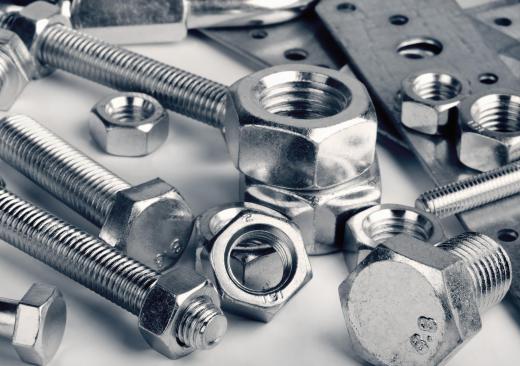An expansion bolt is comprised of a bolt, nut, and lead sleeve assembly that expands upon tightening. These bolts anchor in materials that do not allow for reliable thread formation, such as concrete, brick, and the like. While similar in concept to nail-in anchors with expanding nylon sleeves, expansion bolts are used in heavy duty applications such as securing pews and stadium seating. There are several different configurations.
In the bolt–lead sleeve–tapered nut configuration, a tapered nut rests in a lead sleeve. This entire component is inserted into a pre-drilled hole. The bolt is then inserted, and when fastened, the tapered nut is drawn towards to head of the bolt, causing the lead sleeve to expand.

Another configuration is the bolt–lead sleeve–metal cone–nut. In this type, a metal cone and sleeve rest on the bolt assembly. When the bolt is tightened, the pressure forces the metal cone into the lead sleeve, and this expansion secures the bolt in place. The tapered bolt–lead sleeve–metal cone–nut configuration, though similar to the previous assembly, relies on a tapered bolt head — not a nut — to cause the lead sleeve to expand.
The lead sleeve is the common factor linking the different types of expansion bolt configurations. Lead is malleable, so it easily fills the drilled space in which it is set. Also, due to the lead sleeve, expansion bolts allow for minimal risk of cracking or shattering the anchoring material because expansion bolts do not rely on single points of attachment. The risk of pullout or stripping is also reduced by the lead sleeves.
Depending on the bolt diameter and the materials in which the bolts are tested, expansion bolts under .5 inches (12.7 mm) can be rated in tonnage. Specifications can be found on expansion bolt packaging and correct tolerances should be chosen based on use and risk of corrosion. If there is a high probability of continued exposure to water, cadmium, a group-12 transition metal with similar anti-corrosion properties to zinc, can be added to aid the expansion bolt's resistance to moisture.
In the United States, the American National Standards Institute (ANSI) mandates, among other things, standard and metric sizes and drive types — slotted, hex, double-hex, etc. — of machined parts. Various sizes and drive types of expansion bolt assemblies can be found to suit any need. Expansion bolts and their non-lead components are made of steel and are plated according to American Society for Testing and Materials (ASTM) standards and specifications.
